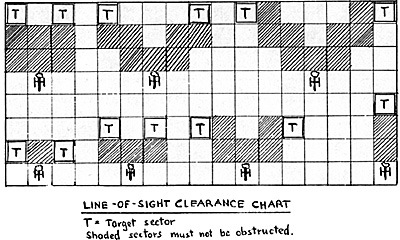| ARTILLERY FIRE | |||||||
|---|---|---|---|---|---|---|---|
| Range Sector |
PRUSSIANS | FRENCH | Range Sector | ||||
| 4/6 PDR AP | 4/6 PDR Shell | SIEGE | 4 PDR AP | 4 PDR Shell | Mitrailleuse | ||
| 1 | 2-3-4-5 | - | - | 2-3-4 | - | 2-3-4-5-6 | 1 |
| 2 | 2-3-4 | - | - | 2-3 | 2-3-4-5 | 2-3-4-5 | 2 |
| 3 | 2-3 | 2-3-4-5 | - | - | 2-3-4 | 2-3-4 | 3 |
| 4 | - | 2-3-4 | 2-3-4-5-6 | - | 2-3 | - | 4 |
| 5 | - | 2-3 | 2-3-4-5 | - | - | - | 5 |
| 6-8 | - | - | 2-3-4 | - | - | - | 6-8 |
| NOTE: Anti-Personnel (A.P.) Shot and Mitrailleuse Fire:
LINE OF SIGHf (Direct). Shell fire and Siege Gun: HIGH TRAJECTORY (indirect). May Fire Over All Obstacles and Troops. MUST ROLL FOR ACCURACY OF AIM! | |||||||
| A. 0. A. CHART ROLL TWO DICE Per Hit | ||
|---|---|---|
| 2 | 5 | 12 |
| 3 | 6,7,8 | 11 |
| 4 | 9 | 10 |
| CASUALTIES OCCUR IN THE SECTOR
WHERE THE SHELL HAS LANDED. | ||
PROCEDURE
After completion of rifle firing, and removal of casualties, both sides fire their artillery pieces simultaneously.
Only guns that have not been moved or unlimbered in that turn may be fired.
To fire, indicate type of load (4/6 par only), select target sector, and roll one die per gun.
Consult hit chart, tag or remove casualties. An enemy gun or gun crew, wiped out by artillery hit(s), may still return fire in this turn.
Guns may be turned (aimed) 900 without loss of firing. A 180 degree turn is considered a move. To fire, guns must be pointed in the direction of the target (see clearance chart)
COMPUTING CASUALTIES
1. PERSONNEL HITS
Pips on hit die (see chart) indicate number of personnel hits.
- An Infantry man, gunner or team horse is killed with 1 hit
a Cavalry man (incl General) is killed with 2 hits (one personnel hit has no effect on cavalry)
in sectors with mixed occupancy, casualties must alternate. If the hit die was even (2-4-6) first casualty will be a Cavalry man, if it was odd (3-5) first casualty will be Infantry man.
Examples:Sector contains 2 Cavalry men (1 tray) and 3 Infantry men (1 tray)
- Hit Die Roll 2 Kills 1 Cav Man
Hit Die Roll 3 Kills 1 Inf & 1 Cav Man
Hit Die Roll 4 Kills 1 Cav & 2 Inf Men
Hit Die Roll 5 Kills 3 Inf & 1 Cav Men
Hit Die Roll 6 Kills 2 Cav & 2 Inf Men
(Note: The extra point, as in the "4" and "5" roll, will be applied against Infantry)
PROTECTIVE COVER
Men in towns, mountains, woods: Deduct 1 pip from hit die
Men inside of buildings or directly behind walls: deduct 2 pips from
hit die
2. DAMAGE TO STRUCTURES AND EQUIPMENT: SHELL FIRE ONLY!
In Addition to the above mentioned casualties inflicted on personnel, the value of the hit die accumulates on structures and equipment as soon as the total value, given in the chart below, is reached, the structure or piece of equipment, is destroyed. A protective structure becomes ineffective in the very same turn of its destruction.
| Type of Structure | POINT Value | Type of Equipment | POINT Value |
|---|---|---|---|
| 4" WALL SECTION | 5 | LIMBER | 3 |
| SMALL BUILDING | 10 | LT. ARTILLERY PIECE | 6 |
| LARGE BRIDGE | 15 | SIEGE GUN | 12 |
NOTE: The pips of the hit die are evenly divided between a wall and a piece of equipment directly behind it, the wall receiving the First hit.
Gun Crews and Teams in Combat
Gun Crews and Limber teams may not attack they defend at 3 CVs per unit, regardless from which direction the attack was made. Casualties: I personnel hit wipes out a cannoneer or a team horse (with or without driver). Cannoneers are subject to casualties while riding the limber. If the hit die roll was even, the First hit goes on a team horse. If it was odd, on a cannoneer.
MOVING ARTILLERY PIECES
The Siege Gun remains stationary throughout the entire game. The Prussians roll 2 dice (Details on page 1 "Setup"), at the beginning of their first turn, for the position of this gun. This position need not to be revealed to the French, unless French units move adjacent to or in with the gun. (In this case the gun is placed on the table at once, the French having the option to Fire at or attack it.) The Prussians may bring on the gun at the beginning of any one of their turns. It cannot be placed into woods. mountains, or towns.
The gun cannot be fired while hidden. It may fire the very first turn it appears on the battle field.
The sector occupied by the Siege Gun is fortified, requiring a 1 pip deduction on hit die.

Part I
Part II
Part III
Part IV
Back to The Armchair General Vol. 1 No. 5 Table of Contents
Back to The Armchair General List of Issues
Back to MagWeb Master Magazine List
© Copyright 1999 by Pat Condray
This article appears in MagWeb (Magazine Web) on the Internet World Wide Web. Other military history articles and gaming articles are available at http://www.magweb.com
